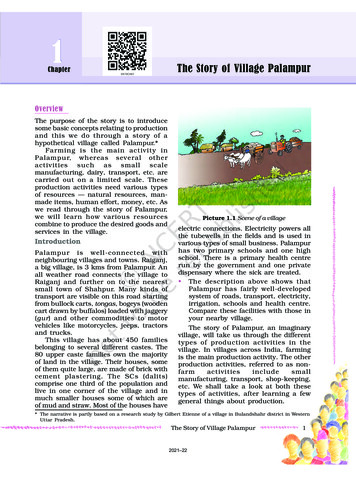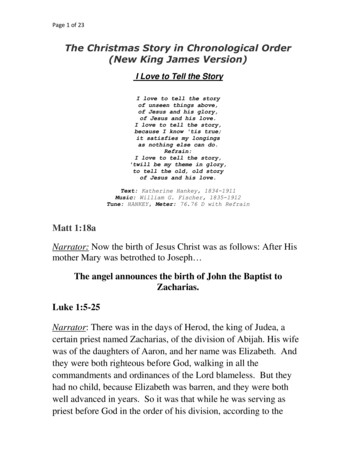
Transcription
1ChapterThe Story of Village PalampurOverviewThe purpose of the story is to introducesome basic concepts relating to productionand this we do through a story of ahypothetical village called Palampur.*Farming is the main activity inPalampur, whereas several otheractivities such as small scalemanufacturing, dairy, transport, etc. arecarried out on a limited scale. Theseproduction activities need various typesof resources — natural resources, manmade items, human effort, money, etc. Aswe read through the story of Palampur,we will learn how various resourcescombine to produce the desired goods andservices in the village.IntroductionPalampur is well-connected withneighbouring villages and towns. Raiganj,a big village, is 3 kms from Palampur. Anall weather road connects the village toRaiganj and further on to the nearestsmall town of Shahpur. Many kinds oftransport are visible on this road startingfrom bullock carts, tongas, bogeys (woodencart drawn by buffalos) loaded with jaggery(gur) and other commodities to motorvehicles like motorcycles, jeeps, tractorsand trucks.This village has about 450 familiesbelonging to several different castes. The80 upper caste families own the majorityof land in the village. Their houses, someof them quite large, are made of brick withcement plastering. The SCs (dalits)comprise one third of the population andlive in one corner of the village and inmuch smaller houses some of which areof mud and straw. Most of the houses havePicture 1.1 Scene of a villageelectric connections. Electricity powers allthe tubewells in the fields and is used invarious types of small business. Palampurhas two primary schools and one highschool. There is a primary health centrerun by the government and one privatedispensary where the sick are treated. The description above shows thatPalampur has fairly well-developedsystem of roads, transport, electricity,irrigation, schools and health centre.Compare these facilities with those inyour nearby village.The story of Palampur, an imaginaryvillage, will take us through the differenttypes of production activities in thevillage. In villages across India, farmingis the main production activity. The otherproduction activities, referred to as nonfarmactivitiesincludesmallmanufacturing, transport, shop-keeping,etc. We shall take a look at both thesetypes of activities, after learning a fewgeneral things about production.* The narrative is partly based on a research study by Gilbert Etienne of a village in Bulandshahr district in WesternUttar Pradesh.The Story of Village Palampur2021–221
Organisation of ProductionThe aim of production is to produce thegoods and services that we want. Thereare four requirements for production ofgoods and services.The first requirement is land, andother natural resources such as water,forests, minerals.The second requirement is labour, i.e.people who will do the work. Someproduction activities require highlyeducated workers to perform thenecessary tasks. Other activities requireworkers who can do manual work. Eachworker is providing the labour necessaryfor production.The third requirement is physicalcapital, i.e. the variety of inputs requiredat every stage during production. Whatare the items that come under physicalcapital?(a) Tools, machines, buildings: Tools andmachines range from very simple toolssuch as a farmer’s plough tosophisticated machines such asgenerators, turbines, computers, etc.Tools, machines, buildings can be usedin production over many years, andare called fixed capital.(b) Raw materials and money in hand:Production requires a variety of rawmaterials such as the yarn used bythe weaver and the clay used by thepotter. A lso, some money is alwaysrequired during production to makepayments and buy other necessaryitems. Raw materials and money inhand are called working capital.Unlike tools, machines and buildings,these are used up in production.There is a fourth requirement too. Youwill need knowledge and enterprise to beable to put together land, labour andphysical capital and produce an outputeither to use yourself or to sell in themarket. This these days is called human2Economics2021–22capital. We shall learn more about humancapital in the next chapter. In the picture, identify the land, labourand fixed capital used in production.Picture 1.2A factory, with several labourersand machinesEvery production is organised bycombining land, labour, physical capitaland human capital, which are known asfactors of production. As we readthrough the story of Palampur, we willlearn more about the first three factorsof production. For convenience, we willrefer to the physical capital as the capitalin this chapter.Farming in Palampur1. Land is fixedFarming is the main production activityin Palampur. 75 per cent of the peoplewho are working are dependent onfarming for their livelihood. They couldbe farmers or farm labourers. The wellbeing of these people is closely related toproduction on the farms.But remember that there is a basicconstraint in raising farm production.Land area under cultivation is practicallyfixed. Since 1960 in Palampur, there hasbeen no expansion in land area under
cultivation. By then, some of thewastelands in the village had beenconverted to cultivable land. There existsno further scope to increase farmproduction by bringing new land undercultivation.larger areas of land more effectively. Thefirst few tubewells were installed by thegovernment. So on, however, farmersstarted setting up private tubewells. As aresult, by mid-1970s the entire cultivatedarea of 200 hectares (ha.) was irrigated.The standard unit of measuring landis hectare, though in the villages youmay find land area being discussedin local units such as bigha, guinthaetc. One hectare equals the area of asquare with one side measuring 100metres. Can you compare the area ofa 1 hectare field with the area of yourschool ground?Not all villages in India have suchhigh levels of irrigation. Apart fromthe riverine plains, coastal regions inour country are well-irrigated. Incontrast, plateau regions such as theDeccan plateau have low levels ofirrigation. Of the total cultivated areain the country a little less than 40per cent is irrigated even today. Inthe remaining areas, farming islargely dependent on rainfall.2. Is there a way one can grow morefrom the same land?In the kind of crops grown and facilitiesavailable, Palampur would resemble avillage of the western part of the state ofUttar Pradesh. All land is cultivated inPalampur. No land is left idle. During therainy season (kharif) farmers grow jowarand bajra. These plants are used as cattlefeed. It is followed by cultivation of potatobetween October and December. In thewinter season (rabi), fields are sown withwheat. From the wheat produced, farmerskeep enough wheat for the family’sconsumption and sell the surplus wheatat the market at Raiganj. A part of theland area is also devoted to sugarcanewhich is harvested once every year.Sugarcane, in its raw form, or as jaggery,is sold to traders in Shahpur.The main reason why farmers are ableto grow three different crops in a year inPalampur is due to the well-developedsystem of irrigation. Electricity came earlyto Palampur. Its major impact was totransform the system of irrigation.Persian wheels were, till then, used byfarmers to draw water from the wells andirrigate small fields. People saw that theelectric-run tubewells could irrigate muchTo grow more than one crop on a piece ofland during the year is known as multiplecropping. It is the most common way ofincreasing production on a given piece ofland. All farmers in Palampur growatleast two main crops; many are growingpotato as the third crop in the past fifteento twenty years.Picture 1.3 Different cropsLet’s Discuss The following Table1.1 shows the landunder cultivation in India in units ofmillion hectares. Plot this on the graphprovided. What does the graph show?Discuss in class.The Story of Village Palampur2021–223
Table 1.1: Cultivated area over the yearsYear1950–511990–912000–012010–11 (P)2011–12 (P)2012–13 (P)2013–14 (P)2014–15 (P)Cultivated Area ( in MillionHectares )132186186198196194201198(P) - Provisional DataSource: Pocket Book of Agriculture Statistics2018, Directorate of Economics and Statistics,Department of Agriculture, Cooperation andFarmers Welfare.Cultivated area (in million hectares)250crop produced on a given piece of landduring a single season. Till the mid1960s, the seeds used in cultivationwere traditional ones with relatively lowyields. T raditional seeds needed lessirrigation. Farmers used cow-dung andother natural manure as fertilizers. Allthese were readily available with thefarmers who did not have to buy them.The Green Revolution in the late 1960sintroduced the Indian farmer tocultivation of wheat and rice using highyielding varieties (HYVs) of seeds.Compared to the traditional seeds, theHYV seeds promised to produce muchgreater amounts of grain on a single plant.As a result, the same piece of land wouldnow produce far larger quantities offoodgrains than was possible earlier. HYVseeds, however, needed plenty of waterand also chemical fertilizers andpesticides to produce best results.Cultivated 22012-132013-142014-15Year Is it important to increase the areaunder irrigation? Why? You have read about the crops grownin Palampur. Fill the following tablebased on information on the cropsgrown in your region.You have seen that one way ofincreasing production from the sameland is by multiple cropping. The otherway is to use modern farming methodsfor higher yield. Yield is measured asName of crop4Month sownPicture 1.4 Modern Farming Methods: HYVseeds, chemical fertilizer etc.Month HarvestedEconomics2021–22Source of irrigation (Rain,tanks, tubewells, canals, etc.)
Higher yields were possible only from acombination of HYV seeds, irrigation,chemical fertilisers, pesticides, etc.Far mers of Punjab, Haryana andWestern Uttar Pradesh were the first totry out the modern farming method inIndia. The farmers in these regions setup tubewells for irrigation, and made useof HYV seeds, chemical fertilisers andpesticides in farming. Some of thembought farm machinery, like tractors andthreshers, which made ploughing andharvesting faster. They were rewardedwith high yields of wheat.In Palampur, the yield of wheat grownfrom the traditional varieties was 1300 kgper hectare. With HYV seeds, the yieldwent up to 3200 kg per hectare. Therewas a large increase in the production ofwheat. Farmers now had greater amountsof surplus wheat to sell in the markets.Let’s Discuss What is the difference between multiplecropping and modern farming method?The following table shows theproduction of wheat and pulses in Indiaafter the Green Revolution in units ofmillion tonnes. Plot this on a graph.Was the Green Revolution equallysuccessful for both the crops? Discuss.What is the working capital requiredby the farmer using modern farmingmethods?Table 1.2: Production of pulses and wheat( in Million 62017-667181910111131415161718Productionof PulsesProductionof 9100Source: Annual Report 2018–19 Department ofAgriculture, Cooperation and Farmers Welfare, as onFebruary, 2019, Government of India. Modern farming methods require thefarmer to start with more cash thanbefore. Why?Suggested Activity During your field visit talk to somefarmers of your region. Find out:1. What kind of farming methods —modern or traditional or mixed — dothe farmers use? Write a note.2. What are the sources of irrigation?3. How much of the cultivated land isirrigated? (very little/nearly half/majority/all)4. From where do farmers obtain theinputs that they require?3. Will the land sustain?Land being a natural resource, it isnecessary to be careful in its use.Scientific reports indicate that the modernfarming methods have overused thenatural resource base.In many areas, Green Revolution isassociated with the loss of soil fertilitydue to increased use of chemicalfertilisers. Also, continuous use ofgroundwater for tubewell irrigation hasled to the depletion of the water-table.Environmental resources, like soil fertilityand groundwater, are built up over years.Once destroyed it is very difficult torestore them. We must take care of theenvironmenttoensurefuturedevelopment of agriculture.Suggested Activity After reading the following reports fromnewspapers/magazines, write a letterto the Agriculture Minister in your ownwords telling him how the use ofchemical fertilisers can be harmful.Chemical fertilisers provideminerals which dissolve in water andare immediately available to plants.But these may not be retained in theThe Story of Village Palampur2021–225
Picture 1.5 Palampur village: Distribution of cultivated landsoil for long. They may escape fromthe soil and pollute groundwater,rivers and lakes. Chemical fertilizerscan also kill bacteria and other microorganisms in the soil. This meanssome time after their use, the soil willbelessfertilethaneverbefore.(Source: Down to Earth, NewDelhi).The consumption of chemicalfertilizers in Punjab is highest in thecountry. The continuous use of chemicalfertilizers has led to degradation of soilhealth. Punjab farmers are now forcedto use more and more chemicalfertilizers and other inputs to achievethe same production level. This meanscost of cultivation is rising veryfast.(Source:TheTribune,Chandigarh)4. How is land distributed betweenthe farmers of Palampur?You must have realised how importantland is for farming. Unfortunately, not allthe people engaged in agriculture havesufficient land for cultivation. In Palampur,about one third of the 450 families arelandless, i.e. 150 families, most of themdalits, have no land for cultivation.Of the remaining families who own6Economics2021–22land, 240 families cultivate small plotsof land less than 2 hectares in size.Cultivation of such plots doesn’t bringadequate income to the farmer family.In 1960, Gobind was a farmer with2.25 hectares of largely unirrigatedland. With the help of his three sonsGobind cultivated the land. Thoughthey didn’t live very comfortably, thefamily managed to feed itself with alittle bit of extra income from onebuffalo that the family possessed.Some years after Gobind’s death, thisland was divided among his threesons. Each one now has a plot of landthat is only 0.75 hectare in size. Evenwith improved irrigation and modernfarming method, Gobind’s sons arenot able to make a living from theirland. They have to look for additionalwork during part of the year.You can see the large number of smallplots scattered around the village in thepicture. These are cultivated by the smallfarmers. On the other hand, more thanhalf the area of the village is covered byplots that are quite large in size. InPalampur, there are 60 families of mediumand large farmers who cultivate morethan 2 hectares of land. A few of the largefarmers have land extending over 10hectares or more.
Picture 1.6 Work onthe fields: Wheat crop—ploughing by bullocks,sowing, spraying ofinsecticides, cultivationby traditional method,cultivation by modernmethod, and cutting ofcrops.Let’s Discuss Let’s DiscussIn the Picture 1.5, can you shade theland cultivated by the small farmers?Why do so many families of farmerscultivate such small plots of land?The distribution of farmers in India andthe amount of land they cultivate is givenin the following Graph 1.1. Discuss inthe classroom.Graph 1.1: Distribution of Cultivated Areaand Farmers Would you agree that the distributionof cultivated land is unequal inPalampur? Do you find a similarsituation for India? Explain.5. Who will provide the labour?After land, labour is the next necessaryfactor for production. Farming requires agreat deal of hard work. Small farmersalong with their families cultivate theirown fields. Thus, they provide the labourrequired for farming themselves. Mediumand large farmers hire farm labourers towork on their fields.Let’s Discuss Medium, Semi-Medium &Large FarmersSource: Pocket Book of Agriculture Statistics2018 and State of Indian Agriculture 2018,Department of Agriculture, Cooperation andFarmers Welfare (As per Agriculture Census,2010 –11).Identify the work being done on thefield in the Pictures 1.6 and arrangethem in a proper sequence.Farm labourers come either fromlandless families or families cultivatingsmall plots of land. Unlike farmers, farmlabourers do not have a right over theThe Story of Village Palampur2021–227
Dala and Ramkali are among the poorest native of the villagePicture 1.7 The conversation between Dala and Ramkalicrops grown on the land. Instead they arepaid wages by the farmer for whom theywork. Wages can be in cash or in kinde.g. crop. Sometimes labourers get mealsalso. Wages vary widely from region toregion, from crop to crop, from one farmactivity to another (like sowing andharvesting). There is also a wide variationin the duration of employment. A farm8Economics2021–22labourer might be employed on a dailybasis, or for one particular farm activitylike harvesting, or for the whole year.Dala is a landless farm labourer whoworks on daily wages in Palampur. Thismeans he must regularly look for work. Theminimum wages for a farm labourer set bythe government is Rs 300 per day (March2019), but Dala gets only Rs 160. There is
heavy competition for work among thefarm labourers in Palampur, so peopleagree to work for lower wages. Dalacomplains about his situation to Ramkali,who is another farm labourer.Both Dala and Ramkali are among thepoorest people in the village.Let’s Discuss Why are farm labourers like Dala andRamkali poor?Gosaipur and Majauli are two villagesin North Bihar. Out of a total of 850households in the two villages, thereare more than 250 men who areemployed in rural Punjab and Haryanaor in Delhi, Mumbai, Surat, Hyderabador Nagpur. Such migration is commonin most villages across India. Why dopeople migrate? Can you describe(based on your imagination) the workthat the migrants of Gosaipur andMajauli might do at the place ofdestination?6. The capital needed in farmingYou have already seen that the modernfarming methods require a great deal ofcapital, so that the farmer now needsmore money than before.1. Most small farmers have to borrowmoney to arrange for the capital. Theyborrow from large farmers or thevillage moneylenders or the traderswho supply various inputs forcultivation. The rate of interest onsuch loans is very high. They are putto great distress to repay the loan.Savita is a small farmer. She plansto cultivate wheat on her 1 hectare ofland. Besides seeds, fertilizers andpesticides, she needs cash to buywater and repair her farminstruments. She estimates that theworking capital itself would cost aminimum of Rs 3,000. She doesn’thave the money, so she decides toborrow from Tejpal Singh, a largefarmer. Tejpal Singh agrees to giveSavita the loan at an interest rate of24 per cent for four months, which isa very high interest rate. Savita alsohas to promise to work on his field asa farm labourer during the harvestseason at Rs 100 per day. As you cantell, this wage is quite low. Savitaknows that she will have to work veryhard to complete harvesting on herown field, and then work as a farmlabourer for Tejpal Singh. The harvesttime is a very busy time. As a motherof three children she has a lot ofhousehold responsibilities. Savitaagrees to these tough conditions asshe knows getting a loan is difficultfor a small farmer.2. In contrast to the small farmers, themedium and large farmers have theirown savings from farming. They arethus able to arrange for the capitalneeded. How do these farmers havetheir own savings? You shall find theanswer in the next section.Let's discuss the story so far.We have read about the three factors ofproduction—land, labour and capital—and how they are used in farming. Let usfill in the blanks given below.Among the three factors of production,we found that labour is the mostabundant factor of production. There aremany people who are willing to work asfarm labourers in the villages, whereasthe opportunities of work are limited. Theybelong to either landless families or. They are paid low wages,and lead a difficult life.In contrast to labour,is a scarce factor of production. Cultivatedland area is. Moreover,even the existing land is distributed(equally/unequally) amongthe people engaged in farming. There area large number of small farmers whocultivate small plots of land and live inThe Story of Village Palampur2021–229
conditions not much better than thelandless farm labourer. To make themaximum use of the existing land,farmersuseand. Both these have led toincrease in production of crops.Modern farming methods require agreat deal of. Smallfarmers usually need to borrow money toarrange for the capital, and are put togreat distress to repay the loan. Therefore,capital too is a scarce factor of production,particularly for the small farmers.Though both land and capital arescarce, there is a basic difference betweenthe two factors of production.is a natural resource,whereasis man-made. Itis possible to increase capital, whereasland is fixed. Therefore, it is veryimportant that we take good care of landand other natural resources used infarming.7. Sale of Surplus Farm ProductsLet us suppose that the farmers haveproduced wheat on their lands using thethree factors of production. The wheatis harvested and production is complete.What do the farmers do with the wheat?They retain a part of the wheat for thefamily’s consumption and sell thesurplus wheat. Small farmers likeSavita and Gobind’s sons have littlesurplus wheat because their totalproduction is small and from this asubstantial share is kept for their ownfamily needs. So it is the medium andlarge farmers who supply wheat to themarket. In the Picture 1.1, you can see thebullock cart streaming into the marketeach carrying loads of wheat. The tradersat the market buy the wheat and sell itfurther to shopkeepers in the towns andcities.10Economics2021–22Tejpal Singh, the large farmer, has asurplus of 350 quintals of wheat from allhis lands! He sells the surplus wheat atthe Raiganj market and has good earnings.What does Tejpal Singh do with hisearnings? Last year, Tejpal Singh had putmost of the money in his bank account.Later he used the savings for lending tofarmers like Savita who were in need of aloan. He also used the savings to arrangefor the working capital for farming in thenext season. This year Tejpal Singh plansto use his earnings to buy another tractor.Another tractor would increase his fixedcapital.Like Tejpal Singh, other large andmedium farmers sell the surplus farmproducts. A part of the earnings is savedand kept for buying capital for the nextseason. Thus, they are able to arrangefor the capital for farming from their ownsavings. Some farmers might also use thesavings to buy cattle, trucks, or to set upshops. As we shall see, these constitutethe capital for non-farm activities.Non-Farm Activities in PalampurWe have learnt about farming as the mainproduction activity in Palampur. We shallnow take a look at some of the non-farmproduction activities. Only 25 per centof the people working in Palampur areengaged in activities other thanagriculture.1. Dairy — the other commonactivityDairy is a common activity in many familiesof Palampur. People feed their buffalos onvarious kinds of grass and the jowar andbajra that grows during the rainy season.The milk is sold in Raiganj, the nearby largevillage. Two traders from Shahpur townhave set up collection cum chilling centresat Raiganj from where the milk istransported to far away towns and cities.
Let's Discuss Let us take three farmers. Each has grown wheat on his field though theproduction is different (see Column 2). The consumption of wheat by eachfarmer family is the same (Column 3). The whole of surplus wheat this yearis used as capital for next year’s production. Also suppose, production istwice the capital used in production. Complete the tables.Farmer 1ProductionConsumptionSurplus Production –ConsumptionCapital for thenext yearYear 1100406060Year 212040SurplusCapital for thenext yearSurplusCapital for thenext yearYear 340Farmer 2Year 1ProductionConsumption8040Year 240Year 340Farmer 3Year 1ProductionConsumption6040Year 240Year 340Let’s Discuss Compare the production of wheat by the three farmers over the years.What happens to Farmer 3 in Year 3? Can he continue production? Whatwill he have to do to continue production?2. An example of small-scalemanufacturing in PalampurAt present, less than fifty people areengaged in manufacturing in Palampur.Unlike the manufacturing that takesplace in the big factories in the townsand cities, manufacturing in Palampurinvolves very simple production methodsThe Story of Village Palampur2021–2211
and are done on a small scale. They arecarried out mostly at home or in the fieldswith the help of family labour. Rarely arelabourers hired.Kareem has opened a computer classcentre in the village. In recent yearsa large number of students have beenattending college in Shahpur town.Kareem found that a number ofstudents from the village are alsoattending computer classes in thetown. There were two women in thevillage who had a degree in computerapplications. He decided to employthem. He bought computers and setup the classes in the front room oftheir house overlooking the market.High school students have startedattending them in good numbers.Mishrilalhaspurchasedamechanical sugarcane crushingmachine run on electricity and hasset it up on his field. Sugarcanecrushing was earlier done with thehelp of bullocks, but people prefer todo it by machines these days.Mishrilal also buys sugarcane fromother farmers and processes it intojaggery. The jaggery is then sold totraders at Shahpur. In the process,Mishrilal makes a small profit.Let’s Discuss Let’s Discuss What capital did Mishrilal need to setup his jaggery manufacturing unit?Who provides the labour in this case?Can you guess why Mishrilal is unableto increase his profit?Could you think of any reasons whenhe might face a loss?Why does Mishrilal sell his jaggery totraders in Shahpur and not in hisvillage? 3. The shopkeepers of PalampurPeople involved in trade (exchange ofgoods) are not many in Palampur. Thetraders of Palampur are shopkeepers whobuy various goods from wholesalemarkets in the cities and sell them inthe village. You will see small generalstores in the village selling a wide rangeof items like rice, wheat, sugar, tea, oil,biscuits, soap, toothpaste, batteries,candles, notebooks, pen, pencil, evensome cloth. A few of the families whosehouses are close to the bus stand haveused a part of the space to open smallshops. They sell eatables.12Economics2021–22In what ways is Kareem’s capital andlabour different from Mishrilal’s?Why didn’t someone start a computercentre earlier? Discuss the possiblereasons.4. Transport: a fast developingsectorThere are variety of vehicles on the roadconnecting Palampur to Raiganj.Rickshawallahs, tongawallahs, jeep,tractor, truck drivers and people drivingthe traditional bullock cart and bogey arepeople in the transport services. Theyferry people and goods from one place toanother, and in return get paid for it. Thenumber of people involved in transporthas grown over the last several years.Kishora is a farm labourer. Like othersuch labourers, Kishora found itdifficult to meet his family’s needs fromthe wages that he received. A few yearsback Kishora took a loan from thebank. This was under a governmentprogramme which was giving cheaploans to poor landless households.Kishora bought a buffalo with thismoney. He now sells the buffalo’s milk.
Further, he has attached a wooden cartto his buffalo and uses it to transportvarious items. Once a week, he goes tothe river Ganga to bring back clay forthe potter. Or sometimes he goes toShahpur with a load of jaggery or othercommodities. Every month he gets somework in transport. As a result, Kishorais able to earn more than what he usedto do some years back.Let’s Discuss What is Kishora’s fixed capital?What do you think would be hisworking capital?In how many production activities isKishora involved?Would you say that K ishora hasbenefitted from better roads inPalampur?SummaryFarming is the main production activity in the village. Over the years there havebeen many important changes in the way farming is practiced. These have allowedthe farmers to produce more crops from the same amount of land. This is animportant achievement, since land is fixed and scarce. But in raising productiona great deal of pressure has been put on land and other natural resources.The new ways of farming need less land, but much more of capital. The mediumand large farmers are able to use their own savings from production to arrangefor capital during the next season. On the other hand, the small farmers whoconstitute about 80 per cent of total farmers in India, find it difficult to obtaincapital. Because of the small size of their plots, their production is not enough.The lack of surplus means that they are unable to obtain capital from their ownsavings, and have to borrow. Besides the debt, many of the small farmers haveto do additional work as farm labourers to feed themselves and their families.Labour being the most abundant factor of production, it would be ideal ifnew ways of farming used much more labour. Unfortunately, such a thing hasnot happened. The use of labour on farms is limited. The labour, looking foropportunities is thus migrating to neighbouring villages, towns and cities. Somelabour has entered the non-farm sector in the village.At present, the non-farm sector in the village is not very large. Out of every100 workers in the rural areas in India, only 24 are engaged in non-farm activities.Though there is a variety of non-farm ac
rainy season (kharif) farmers grow jowar and bajra. These plants are used as cattle feed. It is followed by cultivation of potato between October and December. In the winter season (rabi), fields are sown with wheat. From the wheat produced, farmers keep enough wheat for the family’s co











